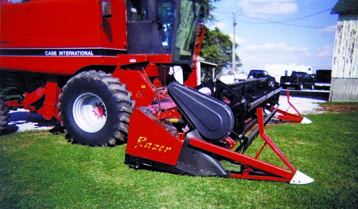"It cuts much cleaner and allows me to harvest two or three times faster than I can with a conventional grain platform," says Tom Loftus, Ivesdale, Ill., who came up with a high speed patented chain-type cutterbar he calls the "Razer" for his Case-IH 1660 combine equipped with a 20-ft grain platform. Loftus had a local machine shop build a 50-ft. long continuous cutter chain, which consists of a continuously rotating chain equipped with replaceable sickle sections. He removed the existing 20-ft. cutterbar and wobble box and replaced them with the new cutting chain and a pair of hydraulic motors. One motor mounts at each end of the chain. As the chain rotates, it returns through a return trough under the platform in a slot that was originally used to store an extra sickle. Chain speed and direction are controlled from the cab. "I used it last summer on wheat and this fall on soybeans and it worked great," says Loftus. "The problem with conventional cutterbars is that they limit harvest speed to 3 or 4 mph. The smooth, constant motion of my continuous chain cutterbar greatly reduces vibration, which in turn reduces shatter loss and allows a faster combine speed. This fall I went 4 to 4 1/2 mph in low 50 bu. per acre soybeans, but I could've gone faster if I'd had a bigger combine -- probably up to 10 mph which is comparable to a row crop head. The higher cutting speed would allow a 20-ft. grain platform to do the same job as a 25 or 30-ft. grain platform equipped with a conventional cutterbar. The higher combine speed will also allow farmers with row crop heads to switch to a grain platform and harvest solid seeded beans without reducing their speed. "The continuously rotating cutterbar has more than twice the cutting surface of a conventional cutterbar and makes equal and full use of all sickle sections. As a result, in row soybeans the sections won't get dull in one spot like they do on a reciprocating cutterbar. Another advantage is that the cutting chain can be run both ways to get full use out of the sickle sections. When the knives are dull on one side, the direction of the chain can be reversed." Loftus says the unit could be adapted to other combine brands.
1-800-834-9665
"Chain-Type" Cutterbar Cuts Fast, Smooth
FARM SHOW Magazine » "Chain-Type" Cutterbar Cuts Fast, Smooth
"Chain-Type" Cutterbar Cuts Fast, Smooth
